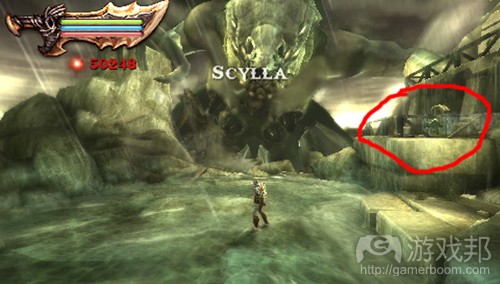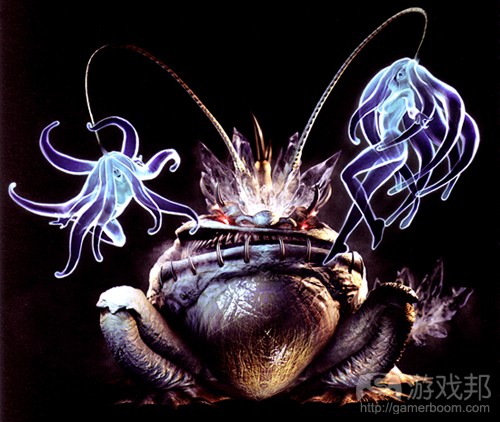阐述借鉴动画准则设计BOSS的5大技巧
作者:Mike Birkhead
真正能测试出战斗游戏设计师能力的就是BOSS,与游戏中其他配角不同,BOSS设计涉及到两个最麻烦的问题:挑战和挫败感。你的任务很困难,而且不幸的是,BOSS设计这个问题远非一篇简单的文章所能阐述清楚的。
我想自己总结出了个简单地解决方案,我每次分析BOSS时都会在脑中思考下这些内容。我的这些知识得益于Ollie Johnston和Frank Thomas两位伟人。
这两个人和迪士尼的其他动画师为我们提供了“动画制作12准则”。这12项准则人尽皆知,我们设计师需要关注的是其中5项:动作预备、动作表现力、节奏、夸张和吸引力。
动作预备
对于动画师来说,动作预备准则的想法是你必须准备角色将进行的动作。如果有角色要挥剑,那么你应当在准备姿态中让他的肌肉拉紧。
但是,我们不是动画师,对于设计师来说,应当确保攻击能够得到“良好的解读”。也就是说,玩家可以读出或者理解BOSS即将做出的行动,这样他才能够做出相应的措施。
也许你曾经听某些设计师说过“这个攻击能够被玩家准确地解读”这句话,当时或许对这句话并不理解,现在你应该知道了其中含义。你需要清晰地解读攻击,但是更为重要的事情往往被多数人所遗忘,那就是拥有清晰的解读能力是不够的。你必须确保你解读的信息不会重叠。
假设我正在设计个巨大的螃蟹BOSS,我想要在这个BOSS中设置两种类型的攻击。
攻击1:蟹爪重击
起始
动画:将右爪举过头顶并击打双钳(80帧)
音效:蟹钳碰击声
攻击
动画:蟹爪重击地面产生冲击波,以0.5英雄单位每秒的速度360度扩展开来,持续时间共2秒
攻击2:蟹爪挥击
起始
动画:向后挥舞右爪(60帧)
音效:挥舞声
攻击
动画:先右后左迅速挥舞蟹爪。右爪覆盖东边的95度弧线,左爪覆盖西边的95度弧线。
这个设计案例有何不当之处呢?事实上,它确有诸多不妥之处。如果你分别审视这两种攻击,似乎它们能够被清楚地解读出来:有大的动作预示即将发生的事情,我们甚至还能听到独特的音效。
但是,当你将他们综合起来看时,你会看到其实有一定问题。举起右爪和向后挥舞右爪,尽管确实有所不同,但是其差异化并不明显。
我们曾经讨论过视觉系统的中央视觉和周围视觉。中央视觉精于捕捉细节,但是在动作感知方法很薄弱,周围视觉恰好相反。
在这两种攻击中,你的眼睛可以感知到动作(游戏邦注:即右爪正在移动),但是如果不将全部注意力集中到蟹爪上,便很难区分出上述两种初始动作的差别。还有,蟹钳碰击声和挥舞声尽管很不错,但听起来很像。
所有这些东西结合起来,使得我们对这两种攻击的解读变得不清晰。但这并不是说你不能以此为目标来设计boss。有时你可能就需要模糊的解读,但是只有在你理解规则之后才可以去打破常规,这是最重要的事情。
动作表现力
动作表现力准则可以简单地描述为:只展示关键的东西。在设计BOSS时,你需要避免其他不相关的细节。这是游戏其他配角设计中非常强大的概念,但是对于BOSS设计来说要特别注意。在你增加解谜机制和互动时,不可将其呈现方式混淆起来。
这个准则不仅适用于你设计的BOSS,还适用于战斗发生的场所。如果你想要让玩家在BOSS战的过程中与某些东西互动,但是这种互动仅发生在某些时刻,那么就要向玩家清晰地传递场景中的东西是否可用的信息。同样,如果BOSS有弱点,那么也应当用显眼的方式来体现这一点。
我们首次测试Scylla Boss(游戏邦注:来自于《战神:斯巴达之魂》)之时,吊车车轮边没有木质栏杆。
在Scylla卧倒之前,吊车车轮毫无作用,但是你仍然可以与之互动。于是,我们看到的情况是,人们不做出任何其他行动,只是与这个车轮互动,而且是一遍遍地尝试!
我们甚至为Scylla设计了特殊攻击,阻止玩家去使用车轮。但是人们丝毫不在意。如果人们发觉可以与场景中的某些东西互动,他们就会这么做。我们遗忘了动作表现力。
节奏
体型庞大的BOSS在移动时应当能够体现出重量感。对于Disney动画师来说,节奏指他们用来展示特定动作的帧数。帧数越多,动作感觉起来越缓慢和越有重量感。
但是,节奏方面有某些有趣的东西。你可能会觉得,因为带有逻辑性,所以动作准备的时间越长,那么避开攻击就越容易。越长越好,不是吗?这种想法可以说对,也可以说不对。你个人做出有效反应的能力并没有呈线式进展。
越长越好这个想法是有时间范围限制的,而依我个人经验,这个临界点就在2秒左右(游戏邦注:最佳的时间在1秒和1.5秒之间)。从我个人经验来看,超过2秒我就需要开始进行计算,这个时候我就不能再只凭感觉做出判断。
所以,很显然你需要在攻击和其他动画上设定良好的节奏,但这还是远远不够的。记住,我们是设计师,所关注的不只是动画。我们所理解的节奏不止是攻击的节奏,还包括展示BOSS弱点的时间。
节奏设计要考虑到战斗过程,而且还必须考虑玩家见到BOSS之前的游戏过程。
夸张
你认为已经过度夸张的元素,也许用在BOSS身上并不为过。设计BOSS需要的并不是精致微妙。之所以要使用夸张,是因为人们喜欢的不是遇到BOSS时就意味着濒临丧命之感,而是喜欢那种受虐之感。
试着去玩玩《战神》中的BOSS。你可以在BOSS战中看到各种绚丽的场景,但是这次体验请不要关注这些,只要注意生命值就可以了。我觉得,你会为自己观察到的结果感到震惊。Kratos无数次被人们以不同方式碾压、抛掷、焚烧和电击,但是生命值并不会迅速减少,游戏在每个危机的时刻都会及时地为玩家奖励大量的生命值。
如果玩家需要不断查看生命值来跟踪战斗的进展情况,那么或许你的设计存在偏差。记住,你的工作不是证明你设计的BOSS多么无敌,而是向玩家证明他们自己的行为多么令人惊叹,你可以通过大量的夸张来实现。
吸引力
最后,我们要探讨的是吸引力。运用这个准则很困难,但也确实可用于设计BOSS:
卡通角色的吸引力类似于演员的魅力。富有吸引力的角色不一定是令人怜悯的角色,坏人或怪物也可以富有吸引力,重点在于观众是否觉得角色真实有趣。
如果我不想去看某个BOSS,那么我就不会从杀戮中获得乐趣。
在为你的BOSS设计弱点时,这个吸引力原则也很重要。如果弱点设计不当,我想多数人都不会想去碰那个BOSS。
《鬼泣》团队很擅长进行弱点设计。《鬼泣4》中的青蛙BOSS有个非常独特的弱点,那就是他的舌头,而他只有在弱点时间循环点到的时候才会伸出舌头。
结语
BOSS设计这个话题所涉及的内容范围远非本文所能涵盖,我向你提供的这些只是简单的工具,是我在审视BOSS时考虑的内容,它们可帮助我思考一些问题:boss是否构建动作准备?重要部分是否良好地表现出来?节奏是否足够恰当?是否有足够的夸张?我是否愿意去尝试杀死这个BOSS?
如果以上这些问题的答案都是肯定的话,那就可以证明这个BOSS很有趣。
游戏邦注:本文发稿于2011年10月20日,所涉时间、事件和数据均以此为准。(本文为游戏邦/gamerboom.com编译,拒绝任何不保留版权的转载,如需转载请联系:游戏邦)
Opinion: Boss Design – Tips From A Combat Designer
Mike Birkhead
There is no truer test of the combat designer than a boss, because they, more than any other cast member, thread those tightest of needles: challenge vs frustration. Your task is difficult, and, unfortunately, this topic of boss design expands far beyond one simple article.
I wish I had a simple solution for you. Every boss is different, though, which means there can be no magic formula. No, one thing, that good bosses have, and bad bosses lack.
What I have for you is Old Knowledge. A checklist, of sorts, that I like to run through in my head whenever I look at a boss. Like all great design tools I am borrowing it from greater men: Ollie Johnston and Frank Thomas.
They, and other animators at Disney, gave us the “12 Principles of Animation.” And of those 12, which are all great to know, we designers are concerned with five: Anticipation, Staging, Timing, Exaggeration, and Appeal.
Anticipation
For animators, the principle of anticipation is the idea that you must prepare for any action the character is going to take. If someone is going to swing their sword, then you should have him tense his muscles in a preparatory motion.
We are not animators, though, and for designers this is known as making sure the attacks have “good reads” – meaning, the player can read, or understand, what the boss is about to do, so that he can react in the appropriate manner.
If you ever heard a designer say, “That attack has clean reads”, and in your head you were wondering what the hell he was talking about, well now you know. You want clean — meaning easily indentifiable, the opposite of muddy — reads on the attacks, but what’s more important (and most people tend to forget) is that it is not enough to have clean reads. You must make sure that your reads do not overlap.
Let’s say I was designing a giant crab boss, and I want to introduce two attacks to the boss.
Attack 1: claw smash
Startup
Anim: raises right claw up above head and clicks claw (80 frames)
Sound: clicking claw sound
Hit
Anim: smashes claw down on the ground and creates a shockwave that expands in 360 degrees at a rate of 0.5 Hero Units a second for a total of 2 seconds.
Attack 2: claw swipes
Startup
Anim: brings right claw back (60 frames)
Sound: chittering sound
Hit
Anim: strikes out with the right, and then left claws in quick succession. The right claw covers a 95 degree arc on the eastern side, while the left claw covers a 95 degree arc on the western side of the crab
What’s wrong with this set up? A couple things, actually. If you look at these attacks separately, then they appear to have clean reads: big motions that set up what’s about to happen, and we even include unique sounds.
When you look at them together, however, you see that we have problems. Raising the right claw up and bringing the right claw back, while certainly different, aren’t really different enough.
Remember in another article we talked about the Foveal vs the Periphery with regards to vision. The foveal (center) of your vision is great at picking out details, but terrible at sensing motion, while the periphery is the exact opposite.
In the case of these two attacks, your eye will sense the motion (the right claw is moving), but without shifting your full focus (foci) to the claw, you won’t be able to tell the difference. What’s more, the sounds of clicking claws and chattering, while cool, really do sound fairly similar.
All of this combines to muddy the reads between these two attacks. That isn’t to say you can’t set out with this intention in mind. Sometimes you may WANT to muddy the reads, but — very serious but — one does not go breaking rules, unless you understand the rules in the first place.
Staging
The principle of Staging can be explained succinctly: show what matters, and only what matters. When designing a boss you want to avoid extraneous details. This is a strong concept with regards to ANY cast member, but for bosses, especially; when you add puzzle mechanics and interactions — as you certainly will — you don’t want to muddy up the presentation.
This principle refers not just to the boss you are designing, though, but also to the arena it takes place in. If you want someone to interact with something during a boss fight, but only at certain moments, then it needs to be either clearly usable, or very clearly unusable; similarly, if the boss has a weak point, then it should be displayed in an obvious way.
The first time we took the Scylla Boss (from Ghost of Sparta) to a play test, we didn’t have the wooden railing around the crane wheel (it gets destroyed when she goes prone for the first time, you will notice).
The crane wheel served no purpose, until Scylla went prone, but you could still interact with it. Well, what do you think happened? People would do nothing BUT interact with it! Over and over and over again. Haha.
We even have special attacks Scylla would play to smash you in the face if you tried to use the wheel (that didn’t work either). People didn’t care. If someone can interact with something, they will. We forgot staging.
Timing
A large boss needs to move like a large boss, which means he needs weight. For the Disney animators, Timing referred to the number of drawings (frames) they would use for a given action. The more frames, the slower and heavier the action would feel.
Here’s the funny thing about timing, though. You would think, because it is logical, that the longer your anticipation, the easier it is to avoid or parry attacks. Longer is better, right? Well, yes and no. Your ability to react effectively doesn’t really follow a linear progression.
Longer IS better, but only to a point, and that point, from my experience, is around 2 seconds (with the sweet spot being between 1 second and 1.5 seconds). In my personal experience, anything beyond 2 seconds I need to start counting. I no longer can react based upon the feel, and that’s usually always a bad thing.
So you need to have good timing on the attacks and other animations, obviously, but there is more to timing. Remember we are designers, so this isn’t just about animation. Timing, here, refers not just to the timing on your attacks, but also to timing on your holds.
A “hold” is the short vulnerability window that you provide on a boss, so that the player can safely get their licks in — you know what I’m talking about. It’s the belly up, “have your way with me” moment.
Anything less than one full combo is not enough — NOT ENOUGH — and remember to take into account the time it will take for your player to traverse over to the boss, too. You don’t want to constantly keep giving the player a halfie.
Exaggeration
However much exaggeration you think is too much, it is not enough for a boss. Bosses are not about subtlety — not at all. They are about larger than life shit happening to larger than life you. Here’s the great thing about exaggeration: people don’t actually like dying on your boss. They just want to feel like they are getting their ass kicked. Really.
Go play a God of War boss. You can pretty much just pick ANY of them, as they all nail this, but this time instead of watching what is happening, just watch your health bar. You’ll be shocked, I think. Kratos gets smashed, flattened, thrown, burned, and electrocuted about a billion different ways, but that little bar won’t go very far, and every Vulnerability moment rewards tons of health, just in case.
If someone has to constantly look up at the health bar to see how things are going, then you’re pretty much doing it wrong. Remember, your job is not to prove how awesome your boss is, but to prove to the player how awesome they are, and you get there with lots of exaggeration.
Appeal
Last but not least we have appeal. This is a tough one, but what was true for Disney back then is true for bosses you design today:
Appeal in a cartoon character corresponds to what would be called charisma in an actor. A character who is appealing is not necessarily sympathetic — villains or monsters can also be appealing — the important thing is that the viewer feels the character is real and interesting.
If I don’t want to look at it, then I’m not going to enjoy killing it. Simple as that.
An aside to this: this principle of Appeal is important to keep in mind when designing weak points for your bosses, too, for if the weak point on a boss is a bunch of spikes, then I’m pretty sure most people will avoid it, as spikes are the very definition of threatening.
Devil May Cry has always been very good about designing weak points. The frog boss from Devil May Cry 4 has a very specific weak point — his tongue — and he only sticks it out when he goes into a well timed Vulnerability Window.
Closing
Designing a boss is a topic that spans far beyond the scope of this article, and as I have said there is no hard rule that you require.
What I have provided you with are some simple tools that I like to keep in my back of my head for when I look at bosses. It helps you to build the right questions to ask. Are they building anticipation? Are the important parts being staged well? Are the timing windows generous (or not generous) enough? Is there enough exaggeration? Do I want to kill this boss?
It’s not like answering yes to all those questions is going to prove the boss is fun to kill, far from it my friend, but they will illuminate your path; and in a world as murky as boss design, you need all the light you can get. (Source: Gamasutra)
下一篇:分享构建灵活的游戏系统的注意要点









































 闽公网安备35020302001549号
闽公网安备35020302001549号